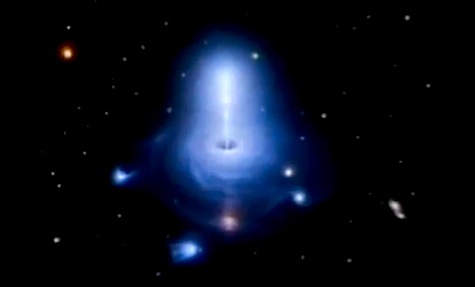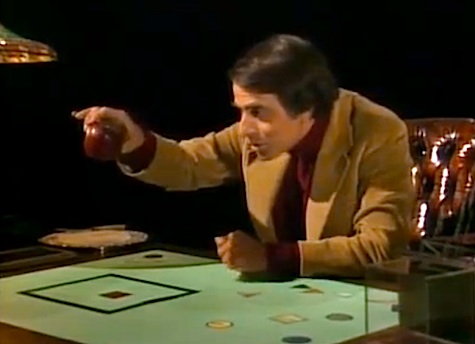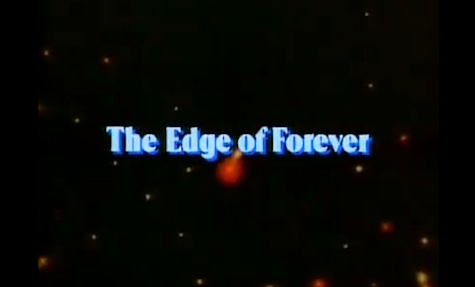The tenth episode of Cosmos, “The Edge of Forever,” is about “the beginnings and ends of worlds, infinity and eternity.” While this may sound like one of the big-idea episodes, it is more a technical one; here, Sagan explores what we know about the structure, age, and ultimate nature of the universe, and how we came to know it. Discussing things like blue/red shift and the implications for our expanding universe, the possibilities for the Big Bang, the nature of three-dimensional imagination and what we might be missing with it, and the conflict between ideas of an oscillating or perpetually expanding universe, Sagan sketches out an understandable framework of our universe for a lay audience.
This is one of the more intriguing “informative” episodes, and I say that because it focuses on a topic that we knew little about when it was created. Sagan acknowledges a great number of speculations, gaps in our theories, and future work to be done in “The Edge of Forever”—more than in any other episode. This one is immersed in questions as much as it is answers, and embraces a sort of radical uncertainty. The entire last half of the episode, after all, focuses on an unresolved argument on the nature of the universe. That uncertainty, and Sagan’s honest exploration of it, offers another view of how we “do” science alongside those of the previous installments—a view that acknowledges how much we didn’t and don’t know.
“How did the universe arise? What was around before that? Might there have been no beginning? Could the universe be infinitely old? Are there boundaries to the Cosmos?”
Sagan opens the episode with these questions and offers what answers he has throughout, leaving plenty of room where the information is missing or contested. This hearkens back to the episode that drew attention to the “big idea” of curiosity in science, and seems to be intended to display that curiosity in action. Asking questions and trying to answer them: it’s sort of what science is about. So, “The Edge of Forever” is doing some interesting work for the audience, in the sense that it is offering a demonstration of what it looks like to be on the edge of research and innovation—not just of the universe. The ostensible subject is cool, but the way Sagan explores it is doing a larger job in the context of the series as a whole.
Before we go any further, though, I have to point out that I don’t have the science background to be able to dissect the facts on offer in this episode. I’m aware that many of them have progressed or changed a great deal since the late ’70s and early ’80s, but don’t know much about it (in fact, if any readers can fill us all in on the current status of any of these ideas, that would be lovely). Sagan gives succinct explanations of otherwise complex ideas like red/blue shifts, the expanding universe, and conflicts between theories; he, as always, uses poetic and clear speech to make the difficult simple for a wide audience. But he also notes the data that’s missing—like what a quasar actually is.

Aside from the science, on which I can’t offer much more commentary, “The Edge of Forever” also does one significant thing that sets it aside from other episodes: it steps outside of the Western, Eurocentric scientific narrative (at least a bit). The second half of the episode spends a great deal of time on selections from the Rig Veda, a Hindu religious text, and a Hindu conception of the universe—in conversation with current Western science, but still. While it’s not a perfect representation, Sagan’s engagement with philosophy outside of that of the Ionians (his favorites) or the general West has been a long time coming, in Cosmos, and I appreciate that other ways of thinking have finally made an appearance.
In fact, he’s rather complementary and positive in his exploration of Hindu theories of the universe, particularly when the tone is compared to his discussions of religion elsewhere in the series. Some examples: discussing India and Hinduism, Sagan says, “Here there is a tradition of skeptical questioning and unselfconscious humility before the great cosmic mysteries.” He also notes that the Big Bang theory “comes from the same human need to solve the cosmological riddle,” and that no one in the world but the ancient Hindus guessed at the vast age of the universe. He calls it an “elegant and much deeper cosmological tradition” as opposed to Western religion. Plus, according to Sagan it’s the only religion that matches up to contemporary scientific dates and understandings (though he says it’s probably by accident, which takes away some of the luster of the comment).
I was surprised by the positivity Sagan shows in his discussion of a religious faith, here. Perhaps the tradition of skepticism and theorizing in Hinduism appeals to him far more than the restrictive and oppressive traditional nature of Western faiths like Christianity. That makes sense, in the context of the series. The problem up for discussion throughout the series, after all, hasn’t been that Sagan thinks faith is always bad—it’s that faith often leads to a repression of science and a refusal to engage with reality. “The Edge of Forever,” in these terms, genuinely evolves the way that Sagan has been representing religion and his own opinions of religion throughout the series: it offers the first genuinely positive reading of a religious viewpoint.
On a less serious note, the Flatland thought experiment, though very familiar, is also a high point of the episode—because Sagan makes it so fun. The little flat square and the apple, and their interaction, are giggle-inducing (when not also faintly disturbing: imagine being that poor two-dimensional person!). The way that Sagan uses it to explain how we can speculate even when we can’t imagine what it would be like to see or exist in four dimensions is clear and concise—probably one of the most coherent explanations of the dimensional problem I’ve ever seen. I think that even a child could understand it, not because it’s simple, but because Sagan is so very good at making things make sense.

There are also a great deal of stunning visuals of galaxies in the first half of the episode that I would happily rewind and watch over and over again. The computer animations of their collisions, their shapes, and their motions, over billions of years—it’s something we could never see, otherwise, but there it is on my television screen. I can watch a ring galaxy form, temporarily, beautiful and scattered. That wouldn’t be possible without technology and the curiosity of scientists who keep pushing at the edge of our available knowledge, and that’s the key to this episode, in my opinion. “The Edge of Forever” has more than one meaning, certainly.
And for once, the pull-away quote that seems to summarize the episode best for me came in the middle. It’s a statement that has become acceptable and commonplace, but it’s still worth noting and spending time considering: our relationship to this expanding, possibly oscillating, strange universe of which we know very, very little—
“The universe seems neither benign nor hostile, merely indifferent to the concerns of such creatures as we.”
It’s big; we’re small. But we can push at the edges to find out more about this universe, no matter how long it takes or how challenging it may be.
*
Come back next week for episode 11, “The Persistence of Memory.”
Lee Mandelo is a writer, critic, and editor whose primary fields of interest are speculative fiction and queer literature, especially when the two coincide. She can be found on Twitter and her website.










